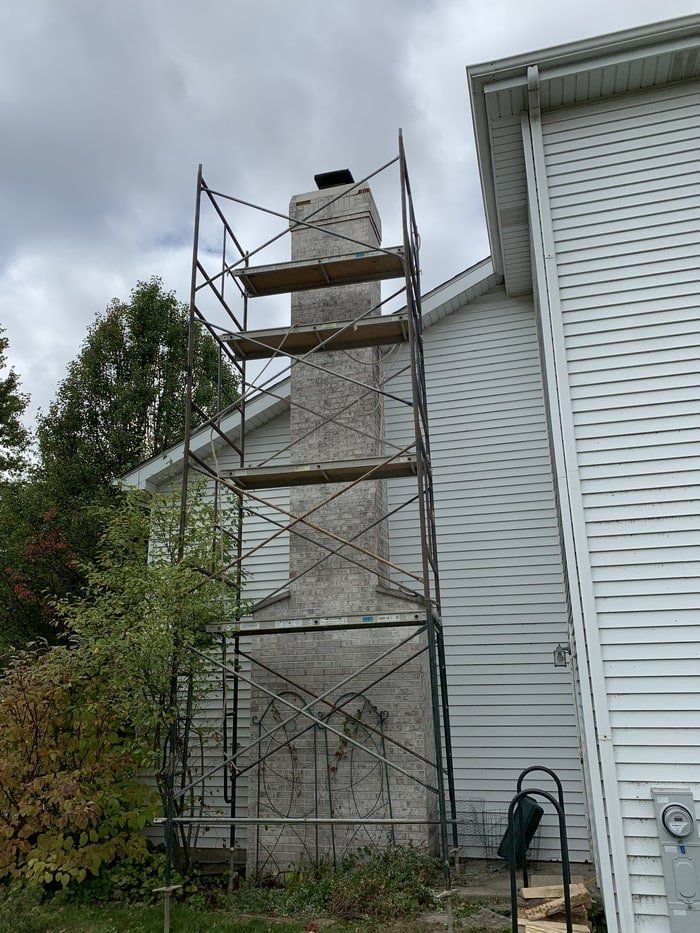Why has my brick wall gone white?
What is efflorescence and what causes it?
Efflorescence is the accumulation of various crystalline deposits with the presence of moisture that can be found in more porous surfaces such as bricks, stucco, concrete, and stone. It is a product of a chemical reaction and is actually quite common in external brickwork in places exposed to frequent rain and higher humidity (aka Chicago). Efflorescence is treated as more of a visual or aesthetic problem and is often not that serious.
There are two main factors why efflorescence happens. These are the primary and secondary factors.
Primary Factor of Efflorescence
The main reason for the emergence of the mineral deposits is because the excess water, or moisture that came from the initial curing between porous substances, pushes the salts to the external surface. This often happens within the first 48 hours from the newly manufactured build and will result in offish-white stains. The materials that are used can be the biggest factor of why efflorescence happens, which is why knowing the appropriate material to use will lessen the possibility of a mineral deposit hardening when there’s moisture.
You should take note that these building materials are highly associated with efflorescence buildup in bricks:
- Sodium Sulfate
- Calcium Sulfate
- Vanadyl Sulfate
Secondary factor:
If that’s not the cause, then the second main cause of the salt deposit is because of the direct contact between an external source of water and the porous building material. When the water dries and the salt evaporates, that’s the time when you’ll see a huge stain covering the bricks throughout your home.
Secondary Efflorescence will happen as long as four of these conditions are present:
1. When there is moisture
Efflorescence will continue to happen and grow as long as the water is present since it is what makes the dissolving of minerals possible.
2. When there are salt deposits
If there are minerals located in the porous material it will mix with water when both are present.
3. Path
If there is a way present for the combined solution of salt minerals and water so they would be able to reach the surface where evaporation comes in.
4. Evaporation
When the combination of water and minerals evaporates, it will leave the salt which will then crystallize; forming the product we call Efflorescence.
How do I know if that's what's actually going on?
Some people may not know how to identify efflorescence as it is new to them and can confuse them for other powdery-like substances like mold.
In order to distinguish mold and efflorescence, you should remember the following:
- Mold can be in any color possible, while efflorescence can only be white, brown, or yellow.
- Mold will not dissolve when mixed with water while efflorescence does.
- Mold will not turn into powder when squeezed between two fingers, while efflorescence does.
How do I remove it from my walls?
Efflorescence is made of a powder-like structure and can easily be removed. Now that you established that efflorescence is indeed covering your wall, you can remove it yourself by:
1. Get a dry hard bristle brush and use it to scrub the powder off your brick walls. Make sure that you cover all the areas of your wall.
2. If there are stubborn bits that cannot be removed by your brush, dampen a sponge slightly (just enough to get it wet, squeeze out the extra liquids), and wipe it on your walls. You may wipe it again with just a small amount of vinegar if there’s still a lot of efflorescence left and then wipe the surface sparingly with water again.
3. When there’s just a small amount of efflorescence left, let your brick wall dry completely.
There are other ways to remove efflorescence, but some of them use liquids such as pressure washing. If your walls have too much substance on them, you can let a professional service do it for you. An expert is needed because doing it the wrong way is risky especially when we now know that moisture can encourage efflorescence to spread and grow even more.
Can I prevent it from growing again?
You can take precautionary measures to lessen the possibility of efflorescence getting into your home’s surface, such as:
- Proper selection of materials
- Execution of carefully researched plans before and during construction
- Proper storage of building materials
In order to avoid getting efflorescence, always remember that the four factors: moisture, salt deposits, path, and evaporation are all necessary for its formation. As long as you prevent one of them to be present successfully, efflorescence will always be prevented to appear in your walls.
Should I worry If I have it?
Efflorescence is often viewed as a minor, nuisance problem as they are temporary and can easily be removed. However, if you want to keep the building structure’s beauty and flair, it would be ideal for you to make sure it does not happen, or, if it already did, prevent it from re-occurring again.
Efflorescence is not dangerous and does not pose a health risk to those living in the building. However, its existence on the surface of your walls would mean that there is a constant presence of moisture, which is not good for your house and might be an underlying symptom of a bigger and more serious problem. It would always be best to take measures to inspect your walls and foundation every now and then to avoid other issues to arise.


